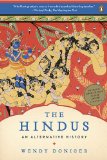“The Hindus: An Alternative History” by Wendy Doniger was in the news recently when its publisher Penguin India decided to withdraw it from India after a prolonged legal fight, fearing for the safety of its employees and its persecution under a repressive and antiquated law. This shameful state of affairs has made it very difficult to get this book in India even though the Indian government hasn't actually banned the book. Thankfully there are other ways to get this book, which is a great relief since I have come to believe that every Indian (and every person seriously interested in India) should read this book as it provides an excellent context for understanding our country. It is really ridiculous that the author is being attacked so viciously by fundamentalists on the far right since if you actually read the book, she comes across as someone with a great love for Hinduism and India. That she has handled this whole affair with grace and poise makes me respect her even more.
The book covers quite a bit of ground, tracing the origins and the development of what we now call Hinduism all the way from pre-historic times to modern times. It is an “alternative history” only in the sense that it shows how women, people of the lower castes and animals were described and treated in Hinduism as it developed over the ages. Since the traditional narratives are dictated by upper-caste males, these alternative voices are rarely heard. It is one of the most comprehensive and well-researched introductory books on this topic, full of copious notes and numerous references. The chapters are more or less in chronological order and cover a lot of ground, though necessarily leaving some things out to make the book viable (the chapters take up close to 800 pages as such).
Having lived most of my life in India, with my formative years spent in northern India, much of the content in this book was familiar to me; even some of the alternative narratives. Quite a few things were still surprising though. For example, I didn't know that gods like Agni and Indra were the main deities in the Vedas, while Brahma and Vishnu weren't, and over the centuries (and numerous texts) the roles were reversed. As another example, I didn't know about the importance (and precedence with respect to the Upanishads) of the Brahmanas. As yet another example, I didn't know that the Ashvamedha yagya, so beloved of the popular epics and mythological stories, used to involve a slaughter of the ritual horse and required the chief queen to mimic copulation with the dead horse. In fact as you read the book you get to realize just how important horses have been to the people living in (and invading) India and how difficult it was for horses to thrive in the country. As a final example, I didn't know that Hinduism initially tried to assimilate Buddhism by portraying Buddha as another avatar of Vishnu, then antagonize Buddhists later on by portraying Buddha as an avatar of Vishnu deliberately misleading the heretics with his teachings (as Buddhism grew in India and attracted devotees and patronage) and finally back to calling Buddhism a sub-set of Hinduism (as its influence waned in India and it became less of a threat).
If your only exposure to Hindu mythology was through Amar Chitra Katha comics and TV serials based on the epics, then you might find this book quite englightening and perhaps some of the content a bit shocking. If you've read direct (unabridged and unsanitized) translations of the texts (or even the Sanskrit originals), much of the content in this book should be familiar as it references texts and commentaries on these texts to construct its narrative. Most of the attacks directed at this book and its author seem to be coming from people who want to push a particular sanitized narrative around Hinduism, ignoring and suppressing the rich diversity of voices it has accumulated over several millenia. I'm fairly confident that most of these people haven't even bothered to read this book fully, though that hasn't stopped them from poisoning web-sites like Amazon and Flipkart with negative reviews aimed at driving down the ratings for this book.
The prose in the book is fairly accessible, even funny in places, though it sometimes lapses into dry academic jargon. I kept finding myself jumping back and forth between the main text and the endnotes, since the endnotes provide more details and sometimes alternative explanations. I really wish the author had provided most of the names in the Devanagari script as well, since the Latin script is abysmal at representing Sanskrit (especially when it comes to Brahma, bhram, Brahmana, brahman, brahmin, etc. - all key to discussing Hinduism) and it became difficult for me at times to relate them to what I knew before. I found it flippant on part of the author to describe the Ramayana and the Mahabharata as “considered by some as epics” - perhaps this was a weird attempt at being tongue-in-cheek.
Minor criticisms aside, this is a book I would heartily recommend to enhance your understanding of Hinduism and India. It is really sad that this book is not readily available in India, since it actually strengthens Hinduism and its study, instead of harming it as some malicious people would have you believe. Satyameva Jayate.
